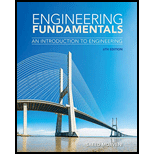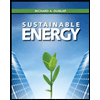
Concept explainers
Investigate the operation of various turbines and explain the operation of steam turbines, hydraulic turbines, gas turbines, and wind turbines.
Explanation of Solution
Turbine:
A turbine is also known as rotary engine that transforms the rotational energy from a fluid or air into a usable energy or work.
The turbine contains a generator, a shaft, and blades. The blade act as a barrier for fluid or air, when the blade moves the energy from the water or air is transferred to the rotor. When the rotor starts to rotate the shaft also rotates and transforms the
Impulse turbine:
Impulse turbine changes the flow path of high velocity fluid. The turbine spins and leaves the kinetic energy from the fluid flow as a result of the impulse. The pressure of the blades does not alter. The total pressure drop takes place in the stationary blades for the steam or gas turbine. The stationary blades is the part which takes place the total pressure drop in the steam or gas turbine.
The fluid pressure head is reformed to velocity head by accelerating the fluid with a nozzle. No pressure casement is required for impulse turbine. The Pelton wheels use the impulse turbine concept exclusively.
Reaction turbine:
The reaction turbine functions are based on the Newton’s third law of motion. The torque developed due to the turbine response to the fluid pressure. The pressure casement is essential for the turbine.
The turbine nozzles are united to the rotor. The Francis turbine and steam turbines are use the concept of reaction turbine. When the fluid leaving through the nozzles, it produces a reaction force on the pipes due to acceleration of fluid. It causes the rotor to change in the direction against to the direction of fluid. Steam turbines and Francis turbine are used by the concept of reaction turbine.
Operation of steam turbine:
The higher amount of mechanical power is produced by the steam turbine applying the less amount of steam. The wheels and blades are attached to the steam turbine rotor. The turbine blade extracts the energy from the steam. It is meant for the electricity production in the thermal power plants. The primary type of steam turbine is the condensing steam turbine.
Operation of hydraulic turbine:
The hydraulic turbine transforms the kinetic energy of the falling water into mechanical energy of rotation. It is used in hydraulic power plants. The modern hydraulic turbines are a form of fluid dynamic machinery of the jet and vane type operating on the principle of impulse or reaction turbine.
Operation of gas turbine:
In gas turbine the air is used as a working fluid. It contains three main components they are downstream turbine on the shaft, upstream rotating gas compressor, and a combustion chamber in the midst of the compressor and the shaft.
The compressor pulls the air into the engine, and push in to the ‘combustion chamber’. It creates the larger amount of pressure and temperature and expands through the turbine section, then the electricity has produced owing to the spinning of generator.
Operation of wind turbine:
Wind turbine works on the principle by which the wind is used to generate mechanical power or electricity. The propellers or blades get rotation while the wind energy strikes on the blades around the rotor. The shaft is connected with rotor and it induce the generator to produce electricity.
Conclusion:
Thus, the operation of steam turbines, hydraulic turbines, gas turbines, and wind turbines is explained.
Want to see more full solutions like this?
Chapter 4 Solutions
ENGINEERING FUNDAMENTALS
- 7.60 This abrupt expansion is to be used to dissipate the high-energy flow of water in the 5-ft-diameter penstock. Assume α = 1.0 at all locations. a. What power (in horsepower) is lost through the expansion? b. If the pressure at section 1 is 5 psig, what is the pressure at section 2? c. What force is needed to hold the expansion in place? 5 ft V = 25 ft/s Problem 7.60 (2) 10 ftarrow_forward7.69 Assume that the head loss in the pipe is given by h₁ = 0.014(L/D) (V²/2g), where L is the length of pipe and D is the pipe diameter. Assume α = 1.0 at all locations. a. Determine the discharge of water through this system. b. Draw the HGL and the EGL for the system. c. Locate the point of maximum pressure. d. Locate the point of minimum pressure. e. Calculate the maximum and minimum pressures in the system. Elevation 100 m Water T = 10°C L = 100 m D = 60 cm Elevation 95 m Elevation 100 m L = 400 m D = 60 cm Elevation = 30 m Nozzle 30 cm diameter jet Problem 7.69arrow_forwardA rectangular flume of planed timber (n=0.012) slopes 0.5 ft per 1000 ft. (i)Compute the discharge if the width is 7 ft and the depth of water is 3.5 ft. (ii) What would be thedischarge if the width were 3.5 ft and depth of water is 7 ft? (iii) Which of the two forms wouldhave greater capacity and which would require less lumber?arrow_forward
- Figure shows a tunnel section on the Colorado River Aqueduct. The area of the water cross section is 191 ft 2 , and the wetted perimeter is 39.1 ft. The flow is 1600 cfs. If n=0.013 for the concrete lining, find the slope.arrow_forward7.48 An engineer is making an estimate for a home owner. This owner has a small stream (Q= 1.4 cfs, T = 40°F) that is located at an elevation H = 34 ft above the owner's residence. The owner is proposing to dam the stream, diverting the flow through a pipe (penstock). This flow will spin a hydraulic turbine, which in turn will drive a generator to produce electrical power. Estimate the maximum power in kilowatts that can be generated if there is no head loss and both the turbine and generator are 100% efficient. Also, estimate the power if the head loss is 5.5 ft, the turbine is 70% efficient, and the generator is 90% efficient. Penstock Turbine and generator Problem 7.48arrow_forwarddesign rectangular sections for the beam and loads, and p values shown. Beam weights are not included in the loads given. Show sketches of cross sections including bar sizes, arrangements, and spacing. Assume concrete weighs 23.5 kN/m'. fy= 420 MPa, and f’c= 21 MPa.Show the shear and moment diagrams as wellarrow_forward
- Draw as a 3D object/Isometricarrow_forwardPost-tensioned AASHTO Type II girders are to be used to support a deck with unsupported span equal to 10 meters. Two levels of Grade 250, 10 x 15.2 mm Ø 7-wire strand are used to tension the girders with 5 tendons per level, where the tendons on top stressed before the ones on the bottom. The girder is simply supported at both ends. The anchors are located 100 mm above the neutral axis at the supports while the eccentricity is measured at 400 mm at the midspan. The tendon profile follows a parabolic shape using a rigid metal sheathing. A concrete topping (slab) 130 mm thick is placed above the beam with a total tributary width of 4 meters. Use maximum values for ranges (table values). Assume that the critical section of the beam is at 0.45LDetermine the losses (friction loss, anchorage, elastic shortening, creep, shrinkage, relaxation). Determine the stresses at the top fibers @ critical section before placing a concrete topping, right after stress transfer. Determine the stress at the…arrow_forwardPlease solve this question in hand writting step by step with diagram drawingarrow_forward
 Engineering Fundamentals: An Introduction to Engi...Civil EngineeringISBN:9781305084766Author:Saeed MoaveniPublisher:Cengage Learning
Engineering Fundamentals: An Introduction to Engi...Civil EngineeringISBN:9781305084766Author:Saeed MoaveniPublisher:Cengage Learning
 Fundamentals Of Construction EstimatingCivil EngineeringISBN:9781337399395Author:Pratt, David J.Publisher:Cengage,
Fundamentals Of Construction EstimatingCivil EngineeringISBN:9781337399395Author:Pratt, David J.Publisher:Cengage, Sustainable EnergyCivil EngineeringISBN:9781133108689Author:Richard A. DunlapPublisher:Cengage Learning
Sustainable EnergyCivil EngineeringISBN:9781133108689Author:Richard A. DunlapPublisher:Cengage Learning



